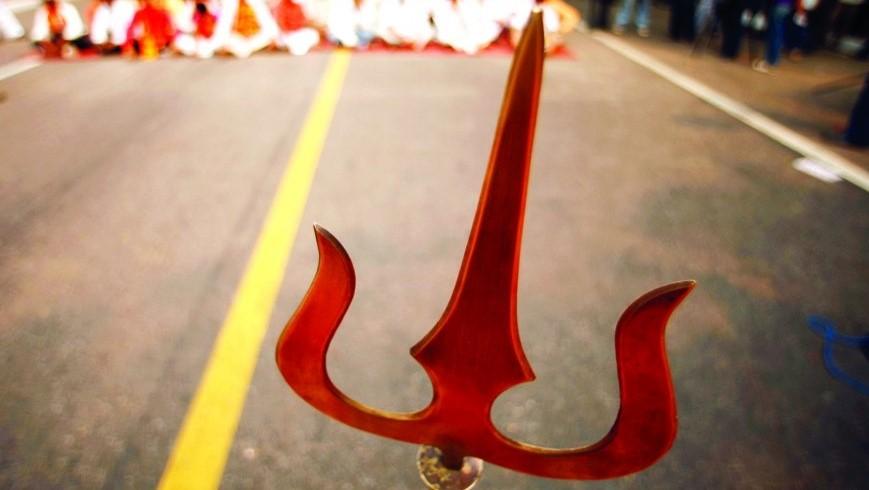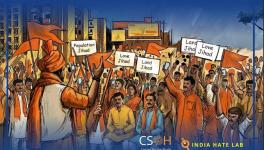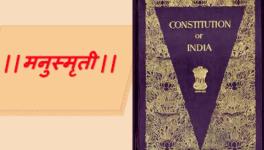Modi's Bharat and "Development" of Hindutva

The current Bharatiya Janata Party (BJP) government came to power with the promises of development and Achche din (good days). The recent Kisan (farmers’) March in Delhi – in which lakhs of farmers from across the country protested against the growing agrarian crisis under this government, the protests by the youth across the country asking for the jobs that the party had promised before the election, the protests by the workers, the peasants and the teachers against economic policies of the government bear a testimony of the failure of this government. As we note the failure of this government in delivering what they had promised – development – it is time to ask what is it that they have done during their rule of five years? The simplest and surest answer to this question is: fuel the communal hatred and violence.
According to the data furnished by the Home Ministry itself, there has been a 28 per cent increase in the instances of communal violence between 2014 and 2017. In 2015, 751 incidents of hate crime were reported. Various reports by the media show that ever since PM Narendra Modi formed his government, there has been a sharp increase in the religious hate crimes in the country. According to the data put together by Hate Crime Watch, 274 incidents of hate crimes were reported between 2009 and 2018, and 59 per cent of the victims in these incidents were Muslims, while 57 per cent of the perpetrators were Hindus. Twenty-eight per cent of these incidents were in the name of cow protection, and 90 per cent of these religious hate crimes since 2009 have occurred after Modi led the BJP to power at the Centre in 2014.
Also read: India, the New Lynchdom
As social activist Harsh Mander writes, this data “compellingly points to the conclusion that an environment has been created under Modi’s watch in which people feel safe, enabled, even encouraged to act out their hate and attack religious minorities”. According to a report published by the Association of Democratic Reforms (ADR), in April 2018, of the total MPs and MLAs, 58 MPs and MLAs had declared cases of hate speech against themselves, while 27 of them belonged to the BJP. These hate speeches, Mander writes, create a “permissive environment for hate attacks”. Modi’s signature response to both the hate speeches by his party members and the hate crimes – barring a few exceptions – has been silence. This silence of the prime minister and his party has normalised the hate for minority identities.
The reason behind the silence of Modi is the ideology and politics of the Hindu Right wing that he and his party have sworn to follow and protect. The ideology of the Hindu Right Wing stands on the “myth of a continuous thousand-year old struggle of Hindus against Muslims as the structuring principle of Indian history”. As Tapan Basu et.al have observed, “The Rashtriya Swayamsevak Sangh (RSS) and the Vishwa Hindu Parishad (VHP) dictate the politics of the Hindu Right, they define the limits within which the BJP can Maneuver. [...] The BJP claims to function within a constitutional, democratic, legal framework; but the activities of the RSS, the VHP and the Bajrang Dal (BD) mock this framework. The politics of the Hindu Right derives its dynamic from the complex relationship between these seemingly opposing tendencies: from their complementarity and contradiction.”
The data shows that the VHP, BD and many such splinters of the Hindu Right have assumed a sense of impunity since the BJP formed its government. The RSS is not only seen everywhere, its members and leaders have been involved in the policy-making as well. One wonders if the “development” that BJP had tom-tommed before the elections was of the politics and ideology of Hindutva?
Development of Hindutva
Demolition of Babri Masjid in Ayodhya on the December 6, 1992 showed that the Hindu Right wing organisations in the country were not just fringe elements; they had grown into powerful organisations. The demolition was not a spontaneous vandalism, but was a consequence of the lessons, trainings, and politics of the Hindutva. As Tapan Basu et.al noted, “Behind the action lies a long history of Hindutva politics which celebrates aggression and violence, declares war against other communities, and scorns at legal and democratic norms.” If Ram was then chosen to be a hero/leader to be fought for, now it is a cow. Back then, they were not in power, but the tables have turned now. Senior political leader Prakash Karat, speaking at Jawaharlal Nehru University (JNU) on the occasion of 26th anniversary of this horrific event, had noted that the coming to power of BJP in 2014 was a logical culmination of the Hindu Right wing.
Looking back at the five years of this government, it indeed seems like a logical culmination of the Hindu Right. The Sangh Parivar (RSS and its affiliates) got legitimised after the BJP formed its government. If the increase in hate crimes against minorities in the country is one of the blatant indicators of this, seeping of RSS into power structures can been seen in the appointments made to the positions of power by the central government.
Also read: How Modi Government Is Destroying Key Indian Institutions
For example, as Achin Vinayak writes, the BJP puts Sangh loyalists into positions of control and authority in each and every case. “If the BJP is in power, appointments favourable for the party are made by the central or state governments. If they are not in power in a state, this cannot be done directly. The BJP, then, uses governmental pressure to ensure this. Coming under the scope of the Sangh, then, are heads and senior personnel of central and state universities and research institutions; bodies empowered to determine the content of textbooks for government schools at central and state levels; cultural academies of various kinds; archival centres; training institutes, from the select and prestigious Indian Institutes of Technology (IITs), to those institutes producing film and television graduates; censorship boards; and so on.” Such appointments were seen in premier institutes like, Film and Television Institute of India (FTII) and JNU.
Since 2014, the RSS is seen openly playing a role at the policy-making level. RSS Joint General Secretary Krishna Gopal chaired a meeting on May 28, 2018, in New Delhi, to discuss the government programmes and policies. The BJP Vice President Vinay Sahasrabuddhe, General Secretary Ram Madhav and Secretary Ram Lal; Union ministers Rajyavardhan Rathore (Information and Broadcasting), JP Nadda (Health), Maneka Gandhi (Women and Child Development), Mahesh Sharma (Culture), Prakash Javadekar (Human Resource Development) and Thawarchand Gehlot (Social Justice) represented the government in the meeting, and met the representatives of the various departments of the RSS. This clearly demonstrates the relationship that the ruling BJP government has with the Hindu fundamentalist body, and shows how the party has been a puppet in the hands of the RSS.
Also Read: Puppet-master RSS is Taking on a More Open Role in the Indian Democracy
Writing about the achievements of the RSS and BJP-led sarkar at the Centre, Purushottam Agarwal, notes, “A leader, even a celebrity, has supporters (and blind supporters too), but not everyone is so fortunate to have such supporters (“Bhakts”) who are ready to confront aggressively not only the opponents of their “hero” but even their own family members too.”
Despite the failure of the PM in fulfilling his promises in 2014, devastating economic policies like GST and demonetisation, the number of “bhakts (devotees)” is seen to be constantly increasing. How is it that a prime minister and a government is spared of their false promises? It is not because people are in awe of the performance of the government, it is because of what is being circulated as information. It is the hatred that is being circulated, and it has become easy to do so with the political face of the ideology of hatred in power.
Get the latest reports & analysis with people's perspective on Protests, movements & deep analytical videos, discussions of the current affairs in your Telegram app. Subscribe to NewsClick's Telegram channel & get Real-Time updates on stories, as they get published on our website.
























